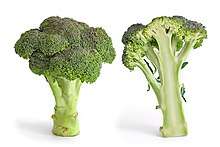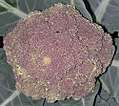Broccoli
Broccoli is an edible green plant in the cabbage family (family Brassicaceae, genus Brassica) whose large flowering head and stalk is eaten as a vegetable. The word broccoli comes from the Italian plural of broccolo, which means "the flowering crest of a cabbage", and is the diminutive form of brocco, meaning "small nail" or "sprout".[3]
| Broccoli | |
|---|---|
 | |
| Species | Brassica oleracea |
| Cultivar group | italica |
| Origin | Italy, more than 2,000 years ago[1][2] |
Broccoli is classified in the Italica cultivar group of the species Brassica oleracea. Broccoli has large flower heads, usually dark green in color, arranged in a tree-like structure branching out from a thick stalk which is usually light green. The mass of flower heads is surrounded by leaves. Broccoli resembles cauliflower, which is a different cultivar group of the same Brassica species. In 2017, China and India combined produced 73% of the world's broccoli and cauliflower crops.[4]
Broccoli resulted from breeding of cultivated Brassica crops in the northern Mediterranean starting in about the sixth century BC.[5] Broccoli has its origins in primitive cultivars grown in the Roman Empire.[6] It is eaten raw or cooked. Broccoli is a particularly rich source of vitamin C and vitamin K. Contents of its characteristic sulfur-containing glucosinolate compounds, isothiocyanates and sulforaphane, are diminished by boiling, but are better preserved by steaming, microwaving or stir-frying.[7]
Rapini, sometimes called "broccoli raab" among other names, forms similar but smaller heads, and is actually a type of turnip (Brassica rapa).
Other cultivar groups of Brassica oleracea

Other cultivar groups of Brassica oleracea include cabbage (Capitata Group), cauliflower and Romanesco broccoli (Botrytis Group), kale and collard (Acephala Group), kohlrabi (Gongylodes Group), Brussels sprouts (Gemmifera Group), and kai-lan (Alboglabra Group).[8] Broccolini or "Tenderstem broccoli" is a cross between broccoli and Chinese broccoli.
Varieties
There are three commonly grown types of broccoli. The most familiar is Calabrese broccoli, often referred to simply as "broccoli", named after Calabria in Italy. It has large (10 to 20 cm) green heads and thick stalks. It is a cool-season annual crop. Sprouting broccoli (white or purple) has a larger number of heads with many thin stalks.[9] Purple cauliflower is a type of broccoli grown in Europe and North America. It has a head shaped like cauliflower, but consisting of tiny flower buds. It sometimes, but not always, has a purple cast to the tips of the flower buds.
Other popular cultivars include Belstar, Blue Wind, Coronado Crown, Destiny, DiCicco, Green Goliath, Green Magic, Purple Sprouting, Romanesco, Sun King and Waltham 29.[10]
Beneforté is a variety of broccoli containing 2–3 times more glucoraphanin and produced by crossing broccoli with a wild Brassica variety, Brassica oleracea var villosa.[11]
Production
In 2017, global production of broccoli (combined for production reports with cauliflowers) was 26.0 million tonnes, with China and India together accounting for 73% of the world total.[4] Secondary producers, each having about one million tonnes or less annually, were the United States, Spain, Mexico and Italy.
In the United States, broccoli is grown year-round in California – which produces 92% of the crop nationally – with 95% of the total crop produced for fresh sales.[12]
| Broccoli production — 2017 (includes cauliflower) | |
|---|---|
| Country | Production millions of tonnes |
Cultivation
The majority of broccoli cultivars are cool-weather crops that do poorly in hot summer weather. Broccoli grows best when exposed to an average daily temperature between 18 and 23 °C (64 and 73 °F).[13] When the cluster of flowers, also referred to as a "head" of broccoli, appear in the center of the plant, the cluster is generally green. Garden pruners or shears are used to cut the head about an inch from the tip. Broccoli should be harvested before the flowers on the head bloom bright yellow.[14]
Pests
Mostly introduced by accident to North America, Australia and New Zealand, "cabbage worms", the larvae of Pieris rapae, also known as the "small white" butterfly, are a common pest in broccoli.[15]
Nutrition
| Nutritional value per 100 g (3.5 oz) | |
|---|---|
| Energy | 141 kJ (34 kcal) |
6.64 g | |
| Sugars | 1.7 g |
| Dietary fiber | 2.6 g |
0.37 g | |
2.82 g | |
| Vitamins | Quantity %DV† |
| Vitamin A equiv. | 4% 31 μg3% 361 μg1403 μg |
| Thiamine (B1) | 6% 0.071 mg |
| Riboflavin (B2) | 10% 0.117 mg |
| Niacin (B3) | 4% 0.639 mg |
| Pantothenic acid (B5) | 11% 0.573 mg |
| Vitamin B6 | 13% 0.175 mg |
| Folate (B9) | 16% 63 μg |
| Choline | 4% 19 mg |
| Vitamin C | 107% 89.2 mg |
| Vitamin E | 5% 0.78 mg |
| Vitamin K | 97% 101.6 μg |
| Minerals | Quantity %DV† |
| Calcium | 5% 47 mg |
| Iron | 6% 0.73 mg |
| Magnesium | 6% 21 mg |
| Manganese | 10% 0.21 mg |
| Phosphorus | 9% 66 mg |
| Potassium | 7% 316 mg |
| Sodium | 2% 33 mg |
| Zinc | 4% 0.41 mg |
| Other constituents | Quantity |
| Water | 89.3 g |
| |
| †Percentages are roughly approximated using US recommendations for adults. Source: USDA Nutrient Database | |
A 100 gram reference serving of raw broccoli provides 34 calories and is a rich source (20% or higher of the Daily Value, DV) of vitamin C (107% DV) and vitamin K (97% DV) (table). Raw broccoli also contains moderate amounts (10–19% DV) of several B vitamins and the dietary mineral manganese, whereas other micronutrients are low in content (less than 10% DV). Raw broccoli is 89% water, 7% carbohydrates, 3% protein, and contains negligible fat (table).
Cooking
Boiling substantially reduces the levels of broccoli glucosinolates, while other cooking methods, such as steaming, microwaving, and stir frying, have no significant effect on glucosinolate levels.[7]
Taste
The perceived bitterness of cruciferous vegetables such as broccoli varies from person to person, but the functional underpinnings of this variation are not known. Some research reports that the gene TAS2R38 may be responsible for bitter taste perception in broccoli.[16] Other factors, such as isothiocyanates and polyphenols, are also likely involved in bitterness perception.[17] In some varieties the normally bitter tasting compounds are in less volatile forms.
Gallery
(NRCS_Photo_Gallery).jpg) Furrow flood irrigation on a field of broccoli raised for seed in Yuma, Arizona.
Furrow flood irrigation on a field of broccoli raised for seed in Yuma, Arizona. Broccoli in flower
Broccoli in flower Sicilian purple broccoli
Sicilian purple broccoli Broccoli "giant", whose flowering head and stalk can reach a kilo.
Broccoli "giant", whose flowering head and stalk can reach a kilo.
See also
- Broccolini


References
- Buck, P. A (1956). "Origin and taxonomy of broccoli". Economic Botany. 10 (3): 250–253. doi:10.1007/bf02899000.
- Stephens, James. "Broccoli—Brassica oleracea L. (Italica group)". University of Florida. p. 1. Retrieved 14 May 2009.
- "broccoli". Merriam-Webster's Collegiate Dictionary (11th ed.). 2004. p. 156. ISBN 978-0-87779-809-5. Retrieved 9 April 2014.
- "Broccoli (and cauliflower) production in 2017, Crops/Regions/World list/Production Quantity (pick lists)". UN Food and Agriculture Organization, Corporate Statistical Database (FAOSTAT). 2018. Retrieved 27 June 2019.
- Maggioni, Lorenzo; Bothmer, Roland; Poulsen, Gert; Branca, Ferdinando (2010). "Origin and Domestication of Cole Crops (Brassica oleracea L.): Linguistic and Literary Considerations". Economic Botany. 64 (2): 109–123. doi:10.1007/s12231-010-9115-2.
- Nonnecke, Ib (November 1989). Vegetable Production. Springer-Verlag New York, LLC. p. 394. ISBN 978-0-442-26721-6.
- Nugrahedi, Probo Y.; Verkerk, Ruud; Widianarko, Budi; Dekker, Matthijs (2015). "A Mechanistic Perspective on Process-Induced Changes in Glucosinolate Content in Brassica Vegetables: A Review". Critical Reviews in Food Science and Nutrition. 55 (6): 823–838. doi:10.1080/10408398.2012.688076. ISSN 1040-8398. PMID 24915330.
- Dixon, G.R. (2007). Vegetable brassicas and related crucifers. Wallingford: CABI. ISBN 978-0-85199-395-9.
- "Broccoli". rhs.org.uk (Royal Horticultural Society). Retrieved 24 March 2020.
- "The Best Broccoli Varieties to Grow Your Own |Gardeners Path". Gardener's Path. 28 June 2018.
- "British research leads to UK-wide launch of Beneforté broccoli". Quadram Institute. 25 June 2012. Retrieved 24 March 2020.
- "Broccoli". Agricultural Marketing Resource Center, US Department of Agriculture. 1 June 2018. Retrieved 27 June 2019.
- Smith, Powell (June 1999). "HGIC 1301 Broccoli". Clemson University. Retrieved 25 August 2009.
- {{cite encyclopedia|title = Broccoli|last = Liptay|first = Albert|year = 1988|publisher =
- editors, J. Richard and Joan E. Heitzman; Jim Rathert, principal photographer; Kathy Love and LuAnne Larsen (1996). Butterflies and moths of Missouri. Jefferson City, MO: Missouri Dept. of Conservation. ISBN 1-887247-06-8.CS1 maint: extra text: authors list (link)
- Lipchock SV, Mennella JA, Spielman AI, Reed DR (2013). "Human bitter perception correlates with bitter receptor messenger RNA expression in taste cells". Am J Clin Nutr. 98 (4): 1136–43. doi:10.3945/ajcn.113.066688. PMC 3778862. PMID 24025627.CS1 maint: uses authors parameter (link)
- Wooding S, Gunn H, Ramos P, Thalmann S, Xing C, Meyerhof W (2010). "Genetics and bitter taste responses to goitrin, a plant toxin found in vegetables". Chem Senses. 35 (8): 685–92. doi:10.1093/chemse/bjq061. PMID 20551074.CS1 maint: uses authors parameter (link)
External links
| Wikimedia Commons has media related to Broccoli. |
- PROTAbase on Brassica oleracea (cauliflower and broccoli)
- List of North American broccoli cultivars, USDA/ARS Vegetable Laboratory
- Lee, Lisa-Ann (22 February 2017). "Creating a broccoli for all seasons to hedge against climate change". newatlas.com. Retrieved 26 February 2017.